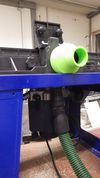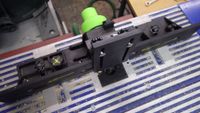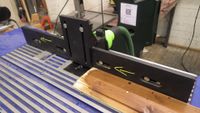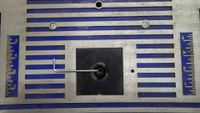Router Table
This tool is not ready for use yet since not all commissioning steps have been completed. The process is also tracked on GitHub. Feel free to contribute to making it usable, any help is very welcome!
| Task | comment | Status |
|---|---|---|
| Name the tool: | Router Table/Westfalia Universal Frästisch Nr. 64 56 97 | done |
| Take a picture | - | done |
| Find the manual as PDF | See infobox | done |
| Documentation | For the moment only the Kingcraft Router is compatible. | done |
| Print QR-Code | use the wikicrawler | done |
| Introduction | added to Handheld Router Introduction | done |
| Security Check | Already improved a lot, but these points are missing (delete when done):
|
80 % |
| Test | Martin: It was tested together with Lukas and worked fine. | done |
| tool's name, owner and approx. value | Owned by Martin, data provided to Lukas with the Dauerleihgabe Form. | done |
| Last step: make it available | physically and in the wiki - then delete this template | pending |
| ToolInfoBox Westfalia Universal Frästisch Nr. 64 56 97 | |
|---|---|
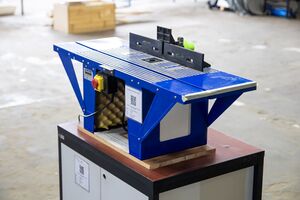
| |
| Synonyms: | DE: Frästisch, Oberfrästisch |
| Type: | tool mount |
| Material: | wood |
| Used with: | routers, push blocks |
| Location: | wood workshop |
| Access Requirements: | upon personal introduction |
| Tutors: | Lukas, Martin |
| Manual: | Westfalia |
A router table turns a handheld router into a stationary tool. The router gets attached to the router table upside down in order to enable the workpiece to be fed through the router (as of this, it is for a router what a table saw is for a circular saw).
It is very important to realize that the exposed router bit is not only dangerous because of its sharp edges, but also because it can rip the workpiece out of your hand and let it fly across the workshop. To make sure that you are in control and not the router, ONLY feed workpieces through from the right to the left side if you are working in front of the router bit and vice-versa! You should understand why this is important after getting the router introduction or reading articles about accidental climb cuts on the internet.
Please also see Project:Router Table in case you would like to join us in building your own.
(Emergency) Stop
To stop the router, you can slap the lid of the yellow switchbox or use the foot switch. When stopping inside a cut, the foot switch is highly recommended so you can keep your hands on the workpiece for full control!
Setup
Dust Extraction
For edge work, you can use the top (green) dust port in the fence, but for grooves you should connect the shop vac to the bottom (black) dust port on the router itself. Keep in mind that the top port will only work if there is at least a small gap in the fence!
It will still be pretty messy work - a router generates lots of shavings - but should help reduce the amount of fine dust flying around.
Fence
The fence consists of several parts which need to be aligned carefully if you want it to be accurate. In most cases (working with a parallel fence), you will not need the knob labeled "X", so please don't mess with it too much...the next user will thank you!
There is a scale on the table to set the fence's distance from the center of the router bit, but it is rather rough and doesn't allow accurate fine measurements. A height/depth gauge, easily made from a caliper and some scrap wood, would be a nice solution (similar to this Instructable, but there are better ones around for sure).
Once you have your bit inserted, the fence's two sliding front sections should be brought as close together as possible for maximum workpiece support and a focused airflow to the dust extraction port. The top guide should be brought down until it nearly touches your workpiece. The frontal guide works the same - we should make compatible featherboards that could actually press the workpiece to the table/fence for even more support.
Unfortunately, the current screw knobs have to be turned very tightly or vibrations will cause everything to shift over time - perhaps we can exchange these knobs with locking levers so that they can be adjusted without pliers.
Improvements/Upgrades
Any modifications to the table or router itself should be discussed with the owner (Martin) in advance and security-checked by a manager afterwards!
done:
- 3D printed shop vac adapter (needed some further adjustment with the table saw) - is the file available somewhere?
- cut two protruding corners from the front guide bracket so it stay mounted to the table all the time without getting in the way
further ideas:
- properly align the mounting plate with the router (currently off-center!)
- make featherboards with slots that fit to the existing guide brackets
- replace (at least) the star knobs connecting the fence and the table with locking levers or knobs with hex nuts that can be gripped with wrenches (do those exist?)
- make push blocks
- make a height/depth gauge to set the fence distance or bit height
Compatible Routers
- The KingCraft KBF-1050E router is currently attached to the table.
More to be determined...
